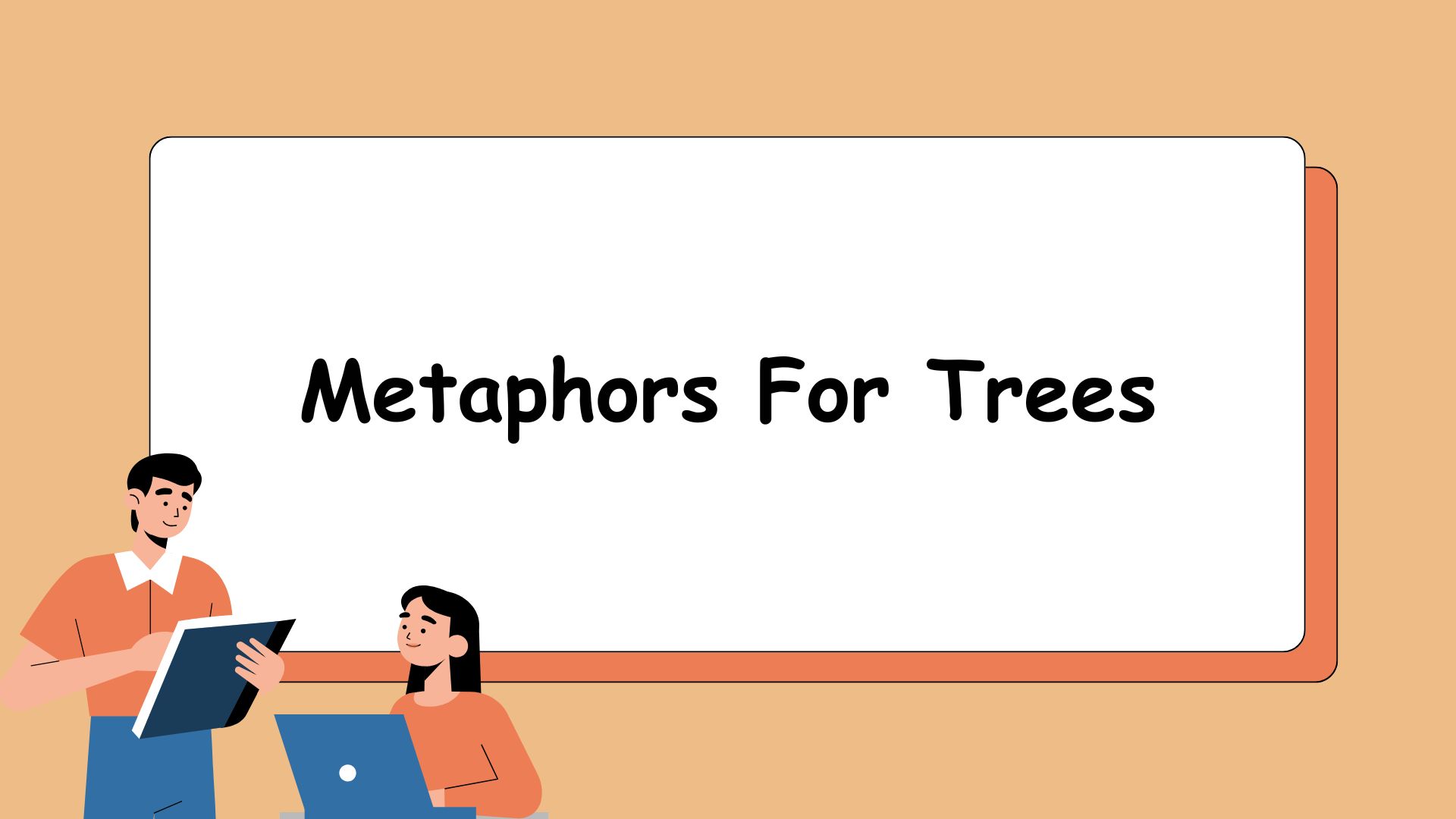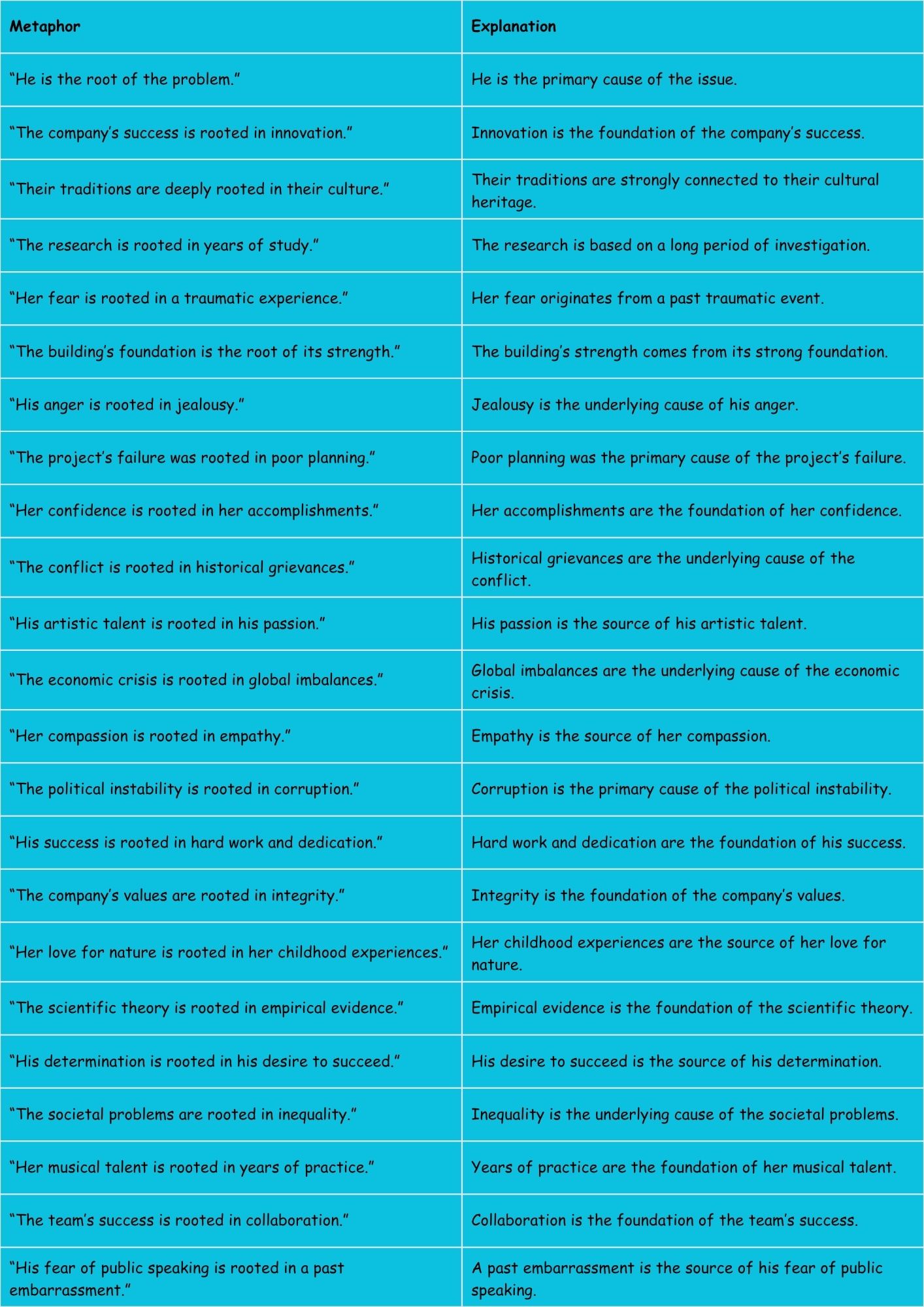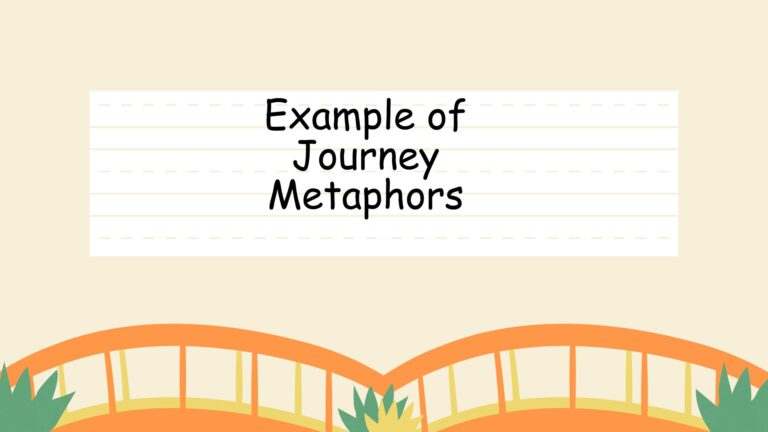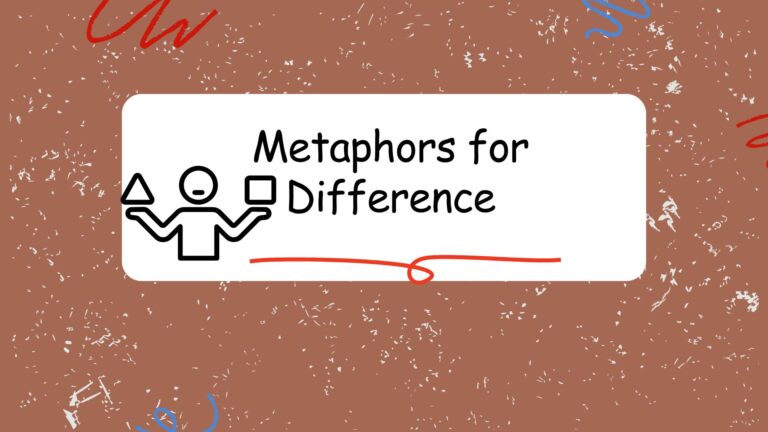
50+ Unique and Iconic Metaphors For Trees

Metaphors are powerful tools in the English language, allowing us to draw comparisons between seemingly unrelated things to enhance understanding and create vivid imagery. Trees, with their complex structures and symbolic associations, are frequently used as metaphors in literature, everyday speech, and even technical contexts. This article explores the various ways trees are employed metaphorically, providing a comprehensive guide for English language learners and enthusiasts alike. Understanding these metaphors will enrich your comprehension of English texts and empower you to use language more creatively and effectively.
This guide is designed for students of all levels, from those just beginning to explore figurative language to advanced learners seeking to refine their understanding. By examining the different types of tree metaphors, their structural elements, and usage rules, you will gain a deeper appreciation for the nuances of the English language. Prepare to delve into the fascinating world of tree metaphors and unlock their potential to elevate your communication skills.
Table of Contents
- Definition of Metaphor and Tree Metaphors
- Structural Breakdown of Tree Metaphors
- Types and Categories of Tree Metaphors
- Examples of Tree Metaphors
- Usage Rules for Tree Metaphors
- Common Mistakes with Tree Metaphors
- Practice Exercises
- Advanced Topics in Tree Metaphors
- Frequently Asked Questions
- Conclusion
Definition of Metaphor and Tree Metaphors
A metaphor is a figure of speech that directly compares two different things without using “like” or “as.” It asserts that one thing *is* another, creating a connection based on shared qualities or characteristics. This comparison isn’t literal; instead, it’s designed to evoke a specific image, feeling, or understanding.
A tree metaphor, therefore, uses the characteristics of a tree – its roots, trunk, branches, leaves, and overall form – to represent something else. Trees are rich in symbolic meaning, often associated with life, growth, strength, family, and knowledge. These associations make them powerful and versatile metaphors.
The function of a tree metaphor is to transfer these associations to the subject being described. For example, saying “He is the root of the problem” uses the tree’s root to symbolize the source or origin of a difficulty. The context in which the metaphor is used is crucial for understanding its intended meaning.
Structural Breakdown of Tree Metaphors
Understanding the structural elements of a tree is essential for grasping the nuances of tree metaphors. Each part of the tree can represent a different aspect of the subject being described:
- Roots: Represent origins, foundations, ancestry, and underlying causes.
- Trunk: Symbolizes strength, stability, core values, and the main body or structure.
- Branches: Represent connections, extensions, possibilities, and the different paths or directions one can take.
- Leaves: Symbolize life, growth, abundance, and temporary or superficial aspects.
- Fruit: Represents results, outcomes, achievements, and the rewards of effort.
- Rings: Symbolize time, history, experience, and growth over time.
- The Entire Tree: Can represent a complete system, organization, family, or individual.
The effectiveness of a tree metaphor depends on the clarity and relevance of the comparison. A well-constructed metaphor will resonate with the audience, creating a vivid and memorable image. The context in which the metaphor is used is also crucial. The same metaphor can have different meanings depending on the situation.
Types and Categories of Tree Metaphors
Life and Growth
Trees are inherently associated with life and growth, making them powerful metaphors for these concepts. They represent the cycle of birth, development, and renewal.
Examples include: “Her career began as a small seed and blossomed into a flourishing tree,” or “Their relationship is a young sapling, needing care and attention to grow strong.” These metaphors emphasize the potential for development and the importance of nurturing growth.
Strength and Stability
The sturdy trunk and deep roots of a tree symbolize strength and stability. These metaphors are often used to describe someone or something that is resilient and dependable.
Examples include: “He is the oak in our family, always providing strength and support,” or “The company is a strong tree, weathering economic storms with resilience.” These metaphors highlight the ability to withstand challenges and provide a solid foundation.
Family and Ancestry
The concept of a family tree directly links trees to lineage and ancestry. These metaphors emphasize the connections between generations and the importance of family history.
Examples include: “We traced our family tree back several generations,” or “She is a descendant of a long line of strong women, deeply rooted in her family’s history.” These metaphors celebrate heritage and the bonds of kinship.
Knowledge and Learning
The image of a “tree of knowledge” is a common metaphor for learning and wisdom. The branches can represent different areas of knowledge, and the roots symbolize the foundational principles.
Examples include: “He has climbed the tree of knowledge, gaining expertise in many fields,” or “Her understanding of the subject is deeply rooted in years of research.” These metaphors emphasize the pursuit of knowledge and the importance of a solid foundation.
Resilience and Adaptability
Trees can withstand harsh weather and adapt to changing environments, making them metaphors for resilience and adaptability. They represent the ability to bounce back from adversity and thrive in challenging circumstances.
Examples include: “Despite the setbacks, she remained a resilient tree, bending but not breaking,” or “The company adapted to the changing market like a tree shedding its leaves in autumn, preparing for new growth.” These metaphors highlight the importance of flexibility and perseverance.
Interconnectedness
Trees in a forest are interconnected through their roots and the ecosystem they create, making them metaphors for interconnectedness and community.
Examples include: “The community is like a forest, with each individual tree contributing to the overall health and well-being of the ecosystem,” or “Their lives were intertwined like the roots of ancient trees, inseparable and mutually supportive.” These metaphors emphasize the importance of collaboration and mutual support.
Examples of Tree Metaphors
Here are several tables providing diverse examples of tree metaphors, categorized by the specific aspect of the tree being emphasized. Each table contains 20-30 examples.
The following table focuses on metaphors that emphasize the roots of a tree, symbolizing origins, foundations, and underlying causes.
| Metaphor | Explanation |
|---|---|
| “He is the root of the problem.” | He is the primary cause of the issue. |
| “The company’s success is rooted in innovation.” | Innovation is the foundation of the company’s success. |
| “Their traditions are deeply rooted in their culture.” | Their traditions are strongly connected to their cultural heritage. |
| “The research is rooted in years of study.” | The research is based on a long period of investigation. |
| “Her fear is rooted in a traumatic experience.” | Her fear originates from a past traumatic event. |
| “The building’s foundation is the root of its strength.” | The building’s strength comes from its strong foundation. |
| “His anger is rooted in jealousy.” | Jealousy is the underlying cause of his anger. |
| “The project’s failure was rooted in poor planning.” | Poor planning was the primary cause of the project’s failure. |
| “Her confidence is rooted in her accomplishments.” | Her accomplishments are the foundation of her confidence. |
| “The conflict is rooted in historical grievances.” | Historical grievances are the underlying cause of the conflict. |
| “His artistic talent is rooted in his passion.” | His passion is the source of his artistic talent. |
| “The economic crisis is rooted in global imbalances.” | Global imbalances are the underlying cause of the economic crisis. |
| “Her compassion is rooted in empathy.” | Empathy is the source of her compassion. |
| “The political instability is rooted in corruption.” | Corruption is the primary cause of the political instability. |
| “His success is rooted in hard work and dedication.” | Hard work and dedication are the foundation of his success. |
| “The company’s values are rooted in integrity.” | Integrity is the foundation of the company’s values. |
| “Her love for nature is rooted in her childhood experiences.” | Her childhood experiences are the source of her love for nature. |
| “The scientific theory is rooted in empirical evidence.” | Empirical evidence is the foundation of the scientific theory. |
| “His determination is rooted in his desire to succeed.” | His desire to succeed is the source of his determination. |
| “The societal problems are rooted in inequality.” | Inequality is the underlying cause of the societal problems. |
| “Her musical talent is rooted in years of practice.” | Years of practice are the foundation of her musical talent. |
| “The team’s success is rooted in collaboration.” | Collaboration is the foundation of the team’s success. |
| “His fear of public speaking is rooted in a past embarrassment.” | A past embarrassment is the source of his fear of public speaking. |

The following table focuses on metaphors that emphasize the trunk of a tree, symbolizing strength, stability, and core values.
| Metaphor | Explanation |
|---|---|
| “He is the oak in our family, always providing strength and support.” | He is the strong and reliable member of the family. |
| “The company is a strong tree, weathering economic storms with resilience.” | The company is resilient and able to withstand economic challenges. |
| “She is the sturdy trunk of the organization, holding everything together.” | She is the stable and dependable person who keeps the organization functioning. |
| “His principles are like the trunk of a tree, unwavering and solid.” | His principles are firm and unchanging. |
| “The building stood like the trunk of an ancient tree, a testament to enduring strength.” | The building was a symbol of lasting strength and resilience. |
| “The law is the trunk of the legal system, providing stability and structure.” | The law is the foundation of the legal system, providing stability. |
| “He remained the unyielding trunk, standing firm against the wind of adversity.” | He remained strong and resilient despite facing challenges. |
| “The foundation of their relationship was the strong trunk that kept them together.” | Their relationship was strong and provided stability. |
| “She was the solid trunk that supported her entire family.” | She was the reliable and supportive person in her family. |
| “The constitution is the trunk of our nation, providing a firm foundation for our laws.” | The constitution is the foundation of the nation’s legal system. |
| “His character was like a sturdy oak trunk, unyielding to temptation.” | His character was strong and resistant to temptation. |
| “The company’s values are the trunk that supports its growth and success.” | The company’s values provide a strong foundation for its success. |
| “She was the unshakeable trunk of her community, a pillar of strength for everyone.” | She was a reliable and supportive member of her community. |
| “The team’s unity was the sturdy trunk that allowed them to overcome any obstacle.” | The team’s unity provided strength and resilience. |
| “His unwavering faith was the trunk that sustained him through difficult times.” | His faith provided strength and support during challenges. |
| “The organization’s mission is the trunk that guides its actions and decisions.” | The organization’s mission provides direction and stability. |
| “She was the strong trunk in the forest of her peers, a beacon of strength and guidance.” | She was a strong and influential figure among her peers. |
| “The school’s traditions are the trunk that connects it to its history and values.” | The school’s traditions provide a connection to its past and values. |
| “His reputation was like a mighty trunk, built on years of integrity and honesty.” | His reputation was strong and built on positive qualities. |
| “The government’s stability is the trunk that supports the nation’s prosperity and security.” | The government’s stability is essential for the nation’s well-being. |
| “She stood as the firm trunk, protecting those around her from the storm.” | She was a protector and provider of safety for those around her. |
| “The community’s resilience was the trunk that allowed them to rebuild after the disaster.” | The community’s resilience enabled them to recover. |
The following table focuses on metaphors that emphasize the branches of a tree, symbolizing connections, extensions, and possibilities.
| Metaphor | Explanation |
|---|---|
| “Her career branched out in several directions.” | Her career expanded into different areas. |
| “The company’s branches extend across the globe.” | The company has operations in many different countries. |
| “His interests branched out into various fields of study.” | He became interested in a wide range of subjects. |
| “The river branched into several smaller streams.” | The river divided into multiple smaller waterways. |
| “Their family tree has many branches, representing different lineages.” | Their family has a complex history with numerous descendants. |
| “The project branched into several sub-projects, each with its own goals.” | The project expanded into multiple smaller projects. |
| “Her influence branched out to touch many lives.” | Her influence spread and affected many people. |
| “The road branched into two separate paths, each leading to a different destination.” | The road divided into two distinct routes. |
| “His ideas branched out to inspire a new generation of thinkers.” | His ideas spread and influenced many others. |
| “The organization’s services branched out to meet the changing needs of the community.” | The organization expanded its services to address community needs. |
| “Her skills branched out to include both writing and public speaking.” | She developed expertise in multiple areas. |
| “The network branched out to connect people from all walks of life.” | The network expanded to include a diverse group of individuals. |
| “His research branched out to explore new and uncharted territories.” | His research expanded into unexplored areas. |
| “The company’s products branched out to cater to a wider range of customers.” | The company expanded its product line to appeal to more customers. |
| “Her compassion branched out to encompass all living creatures.” | Her compassion extended to all forms of life. |
| “The political movement branched out to include people from different backgrounds.” | The political movement expanded its membership to include diverse individuals. |
| “His artistic vision branched out to encompass multiple forms of expression.” | His artistic vision expanded to include various mediums. |
| “The educational program branched out to offer courses in various disciplines.” | The educational program expanded its curriculum to include different subjects. |
| “Her interests branched out to include both science and art.” | She developed interests in both scientific and artistic fields. |
| “The organization’s mission branched out to address multiple social issues.” | The organization expanded its mission to tackle various social problems. |
| “His career branched out after he took on a new role in the company.” | His career expanded after he took on a new role in the company. |
| “The project branched out to include new team members and stakeholders.” | The project expanded to include new team members and stakeholders. |
The following table focuses on metaphors that emphasize the leaves of a tree, symbolizing life, growth, abundance, and temporary or superficial aspects.
| Metaphor | Explanation |
|---|---|
| “Their success was like leaves on a tree, abundant and flourishing.” | Their success was plentiful and thriving. |
| “Her ideas were like leaves, constantly changing and evolving.” | Her ideas were dynamic and ever-changing. |
| “The memories were like autumn leaves, beautiful but fleeting.” | The memories were lovely but temporary. |
| “His words were like leaves rustling in the wind, often meaningless and empty.” | His words were often insubstantial and without significance. |
| “The crowd was like leaves on a tree, numerous and swaying in unison.” | The crowd was large and moving together. |
| “Their relationship was like a tree in full leaf, vibrant and full of life.” | Their relationship was lively and thriving. |
| “The opportunities were like leaves falling from a tree, abundant and readily available.” | There were many opportunities available. |
| “His emotions were like leaves in the wind, easily swayed and unpredictable.” | His emotions were unstable and difficult to predict. |
| “The city was like a tree in full leaf, bustling with activity and life.” | The city was vibrant and full of activity. |
| “Their dreams were like leaves reaching for the sun, full of hope and potential.” | Their dreams were ambitious and full of promise. |
| “His promises were like autumn leaves, easily broken and scattered.” | His promises were unreliable and easily forgotten. |
| “The changes were like leaves turning color, a beautiful but inevitable process.” | The changes were attractive but unavoidable. |
| “Her thoughts were like leaves dancing in the breeze, light and carefree.” | Her thoughts were lighthearted and untroubled. |
| “The challenges were like leaves falling on their path, unavoidable but manageable.” | The challenges were inevitable but could be overcome. |
| “His words were like leaves in spring, fresh and full of promise.” | His words were new and optimistic. |
| “The opportunities were like leaves on a tree, each one unique and valuable.” | The opportunities were distinct and worthwhile. |
| “Her ideas were like leaves unfolding, gradually revealing their beauty and complexity.” | Her ideas were slowly developing and showing their value. |
| “The memories were like leaves pressed in a book, preserved and cherished.” | The memories were valued and kept safe. |
| “His emotions were like leaves changing color, reflecting the season of his life.” | His emotions were reflective of his current stage in life. |
| “The opportunities were like leaves scattered on the ground, waiting to be discovered.” | There were many hidden opportunities available. |
| “His words were as plentiful as leaves on a tree in springtime.” | His words were very plentiful. |

Usage Rules for Tree Metaphors
Using tree metaphors effectively requires attention to several key rules:
- Context is crucial: The meaning of a tree metaphor depends heavily on the context in which it is used. Consider the audience, the subject being described, and the overall tone of the communication.
- Clarity is essential: The comparison should be clear and relevant. Avoid using metaphors that are too abstract or obscure, as they may confuse the audience.
- Consistency matters: Maintain consistency within the metaphor. If you start by comparing someone to the roots of a tree, avoid switching to the branches or leaves without a clear reason.
- Avoid clichés: While some tree metaphors are common, try to avoid overused expressions. Strive for originality and creativity in your comparisons.
- Consider the cultural context: Different cultures may have different associations with trees. Be mindful of these cultural differences when using tree metaphors in cross-cultural communication.
Common Mistakes with Tree Metaphors
Here are some common mistakes to avoid when using tree metaphors:
| Incorrect | Correct | Explanation |
|---|---|---|
| “He is the leaf of the problem.” | “He is the root of the problem.” | Leaves are superficial, while roots represent the source. |
| “Her knowledge branched out from the roots.” | “Her knowledge grew from the roots.” | Knowledge doesn’t branch out *from* roots; it grows *from* a foundation. |
| “The company is a falling tree.” | “The company is a struggling tree.” | “Falling tree” implies a sudden event, while “struggling tree” suggests a process. |
| “He is a tree without leaves, full of life.” | “He is a tree without leaves, dormant but full of potential.” | Trees without leaves are not “full of life” in the active sense, but can be dormant. |
Practice Exercises
Test your understanding of tree metaphors with these exercises. For each sentence, identify the tree metaphor and explain its meaning.
Exercise 1: Identifying Tree Metaphors
| Question | Answer |
|---|---|
| 1. The project’s success was rooted in careful planning. | The metaphor is “rooted in careful planning.” It means the project’s success was based on or originated from careful planning. |
| 2. She is the sturdy oak of her family, always providing support. | The metaphor is “sturdy oak.” It means she is strong, reliable, and supportive. |
| 3. His career branched out into many different areas. | The metaphor is “branched out.” It means his career expanded into various fields. |
| 4. The company weathered the storm like a resilient tree. | The metaphor is “resilient tree.” It means the company showed strength and adaptability in overcoming challenges. |
| 5. Their relationship is a young sapling, needing time to grow. | The metaphor is “young sapling.” It means their relationship is new and requires nurturing to develop. |
| 6. His ideas were like leaves in the wind, scattered and unorganized. | The metaphor is “leaves in the wind.” It means his ideas were disorganized and lacked focus. |
| 7. She climbed the tree of knowledge to become an expert in her field. | The metaphor is “tree of knowledge.” It means she pursued learning and wisdom to gain expertise. |
| 8. The community is a forest, with each member contributing to the whole. | The metaphor is “a forest.” It means the community is an interconnected ecosystem where each individual plays a vital role. |
| 9. His anger was rooted in years of resentment. | The metaphor is “rooted in years of resentment.” It means his anger originated from or was based on long-standing resentment. |
| 10. The organization’s values are the trunk that supports its mission. | The metaphor is “the trunk.” It means the organization’s values provide a strong foundation for its mission. |
Exercise 2: Completing Tree Metaphors
Complete the following sentences by adding an appropriate tree metaphor.
| Question | Answer |
|---|---|
| 1. The project’s foundation was strong, ________. | The project’s foundation was strong, like the roots of an ancient oak. |
| 2. Her influence spread throughout the company, ________. | Her influence spread throughout the company, branching out like the limbs of a tree. |
| 3. Despite the challenges, he remained steadfast, ________. | Despite the challenges, he remained steadfast, a sturdy trunk against the storm. |
| 4. Their ideas were constantly evolving, ________. | Their ideas were constantly evolving, like leaves changing color in the fall. |
| 5. The family’s history was rich and complex, ________. | The family’s history was rich and complex, a sprawling family tree with countless branches. |
| 6. Her success was based on hard work, ________. | Her success was based on hard work, rooted deeply in dedication and perseverance. |
| 7. The team’s unity provided strength, ________. | The team’s unity provided strength, like the intertwined roots of a forest. |
| 8. The city was vibrant and full of life, ________. | The city was vibrant and full of life, a tree in full leaf during springtime. |
| 9. The company’s mission provided guidance, ________. | The company’s mission provided guidance, the trunk that kept them on course. |
| 10. His knowledge expanded over time, ________. | His knowledge expanded over time, like climbing the tree of wisdom. |
Advanced Topics in Tree Metaphors
For advanced learners, consider exploring the following topics:
- Extended metaphors: These are metaphors that are developed over several sentences or paragraphs, creating a more complex and nuanced comparison.
- Mixed metaphors: These are metaphors that combine inconsistent images or ideas, often unintentionally creating a humorous or confusing effect.
- Symbolism: Explore the deeper symbolic meanings associated with different types of trees in literature and mythology.
- Cultural variations: Investigate how tree metaphors are used differently in various cultures and languages.
Frequently Asked Questions
- What is the difference between a metaphor and a simile?Both metaphors and similes are figures of speech that compare two different things. However, a metaphor directly states that one thing *is* another, while a simile uses “like” or “as” to make the comparison. For example, “He is a lion” is a metaphor, while “He is as brave as a lion” is a simile.
- How can I identify a metaphor in a sentence?Look for statements that are not literally true but imply a comparison between two different things. Ask yourself if the statement is meant to be taken literally or if it is intended to create a particular image or feeling.
- Why are tree metaphors so common?Trees are rich in symbolic meaning and have universal associations with life, growth, strength, and family. These associations make them versatile and effective metaphors for a wide range of concepts.
- Can a tree metaphor be used in technical writing?Yes, but it’s important to use them carefully and ensure that they enhance clarity rather than create confusion. In technical writing, tree metaphors are often used to describe hierarchical structures or processes.
- How can I improve my ability to use tree metaphors effectively?Read widely, pay attention to how other writers use metaphors, and practice using them in your own writing. Consider the specific qualities of the tree you are referencing and how they relate to the subject you are describing.
- What are some common symbols associated with different types of trees?Oaks often symbolize strength and resilience. Willows symbolize grace and mourning. Pines symbolize longevity and immortality. Birches symbolize new beginnings and purification. Understanding these associations can help you choose the most appropriate tree metaphor for your intended meaning.
- How do cultural differences affect the interpretation of tree metaphors?Different cultures may have different associations with specific trees. For example, in some cultures, the bamboo tree symbolizes flexibility and resilience, while in others, it may be associated with weakness. Being aware of these cultural differences is crucial for effective cross-cultural communication.
- Are there any situations where using a tree metaphor would be inappropriate?Avoid using tree metaphors in situations where clarity and precision are paramount, such as in legal documents or scientific reports. Also, be mindful of your audience and avoid using metaphors that may be confusing or offensive to them.
Conclusion
Tree metaphors offer a rich and versatile way to enhance your communication skills. By understanding the structural elements of trees and their symbolic associations, you can use these metaphors to create vivid imagery, convey complex ideas, and connect with your audience on a deeper level. Remember to consider the context, maintain clarity, and avoid clichés to use tree metaphors effectively.
As you continue to explore the English language, pay attention to the metaphors that you encounter and practice using them in your own writing and speech. With time and practice, you will develop a strong command of tree metaphors and be able to use them to express yourself with greater creativity and precision. Embrace the power of figurative language and watch your communication skills flourish like a well-nourished tree.



